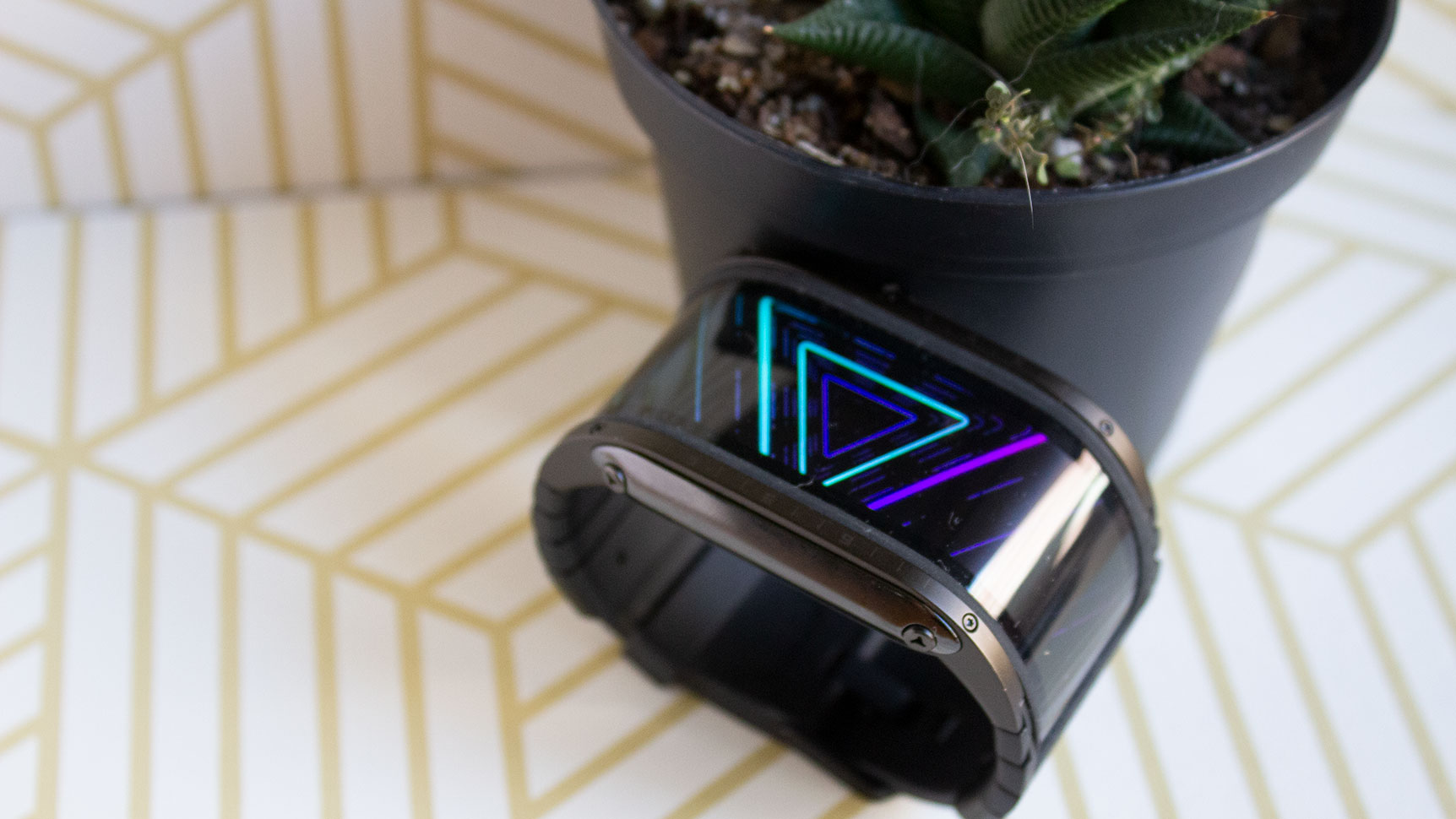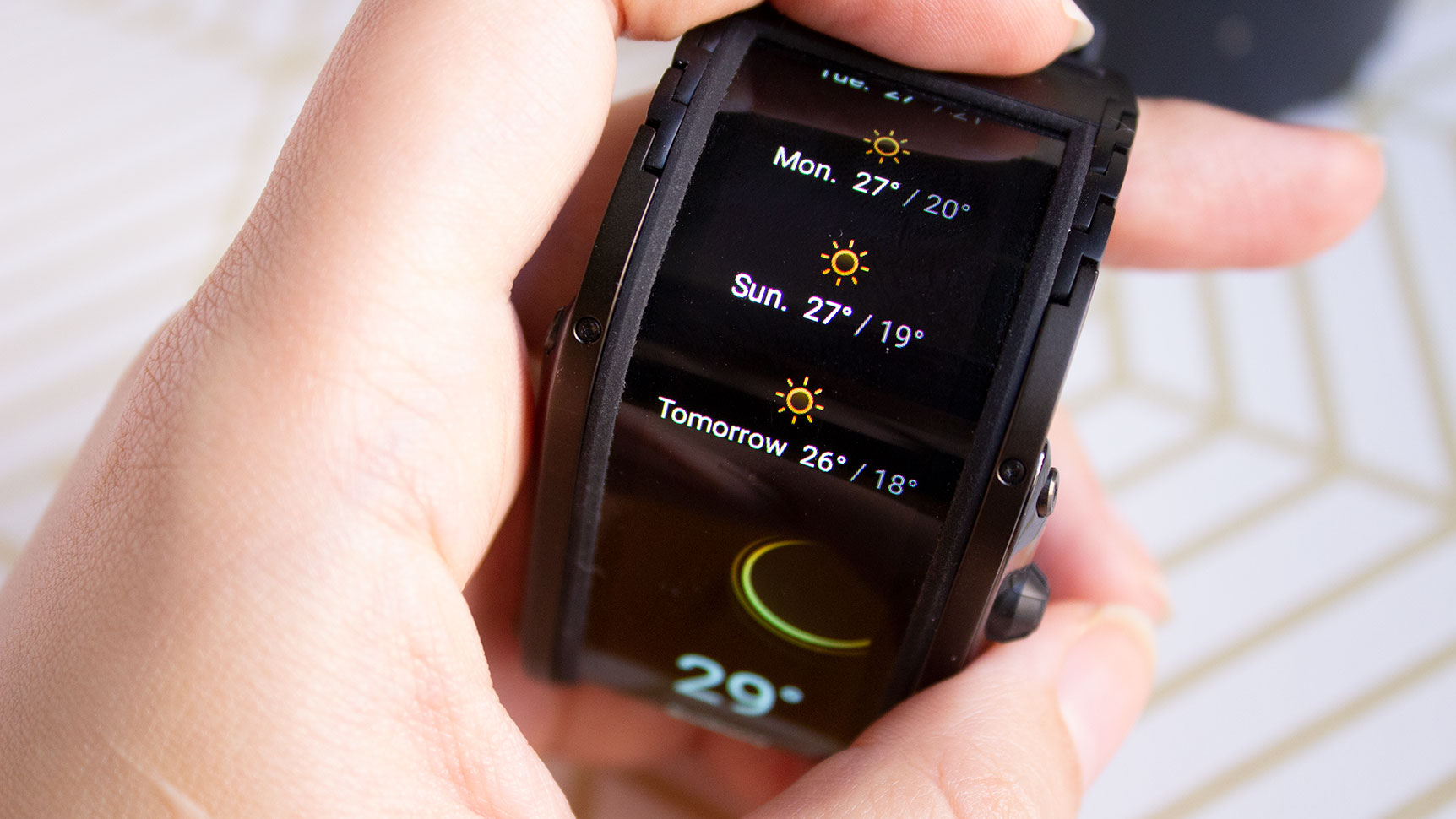A curved AMOLED smartwatch sounds like the stuff of science fiction, and the Nubia Watch has certainly been described as futuristic — including by yours truly, who has used the word to explain the watch to coworkers and friends. But after wearing one for over a week, it’s more 2016 than 2020, much less like anything from the future.
You wouldn’t be able to tell how old-school it is just by looking at it. After all, as advanced as the Apple Watch and Samsung’s Galaxy Watch 3 are, they still look like what you’d expect from a smartwatch. Meanwhile, the Nubia Watch is a curved 4.01-inch flexible display that wraps around your wrist. It’s sort of like someone took the concept of a smartwatch being a smartphone for your wrist extremely literally, and then made it a reality.
Like many gadget nerds, most of what I knew about the Nubia Watch, and its predecessor the Nubia Alpha, came from first-look write-ups and videos of the device on YouTube. Watching them, I made that “oh, dang” face, so when the chance to try it out myself landed in my lap, I jumped at it. But I was fairly disappointed when I opened the box itself. In person, without the display turned on, it was a big, chunky thing that was actually pretty rigid for something with a “flexible” display.

Nubia Watch
What is it?
Nubia's second 'flexible' smartwatch
Price
$US400 ($549) retail; $274 early bird on Kickstarter
Like
The screen is cool.
No Like
It's too buggy to be this expensive. Functionally, it isn't as advanced as it might look.
I’m not sure what I was expecting. Fireworks to come out of my wrist? A hologram? Probably what I wanted most was to strap this thing on and feel the future had arrived. What actually happened was I turned the thing on, scrolled through the terms of service, and went, “Oh, I can’t actually read stuff on the sides of the curved screen.”
Don’t get me wrong! The screen is cool. I admit to being wowed by some of the animated “barrage” graphics. It’s also kinda neat that when you swipe up for notifications, you can scroll quite far thanks to the extended length. (That said, you can see some pixels if you look closely, which not terribly surprising because the display has a pixel density of 244 ppi.) It’s just that, uh, outside of the various watch faces, the software and apps aren’t really optimised for this screen. Things are awkwardly sized, and even though you can scroll, sometimes you do have to contort your wrist to hit a relevant on-screen button.
Full disclosure: Nubia sent me an early Chinese version of the watch. As such, I didn’t have the final software on my review unit. That might be a good thing because, hoo boy, this was a buggy ride from start to finish.
Things like setting alarms, checking the weather app, reading notifications — that all worked as normal. It was weird occasionally having to twist my arm to see the sides of the screen, but these basic apps work as you expect them to. It’s when I tried to call from the wrist, reply to texts, load music and photos, and track workouts that things got wonky.
First off, I couldn’t get calls to work despite the fact it was connected to my wifi and to my phone over Bluetooth. That just did not happen for me. I also only intermittently got messages on the wrist — mostly through Signal app notifications. Texts? Nah. I tried to load my Apple Music library onto the watch and I got most of the way there! I granted permission, got a list of songs to show up on the Nubia app, and even selected which ones I wanted to import. They just… never made it onto the watch before things crashed. The same happened for photos. I followed the instructions in the app to a T by pairing the watch to my phone’s personal hotspot. Nada. Again, this could very well be due to the fact I wasn’t using the final version of the watch.

When it came to activity-tracking, my options were limited. You only get four types of workouts to choose from: a “free” workout (a catch-all type of exercise), outdoor walking, indoor running, and outdoor running. That’s fine. What’s not fine is the results I got weren’t accurate. I went on three runs with the Nubia Watch, and each time it struggled to find a GPS signal, despite having built-in GPS. This could be due to the fact that I live right nearby a river and New York City isn’t exactly the best when it comes to GPS signals. I ran into this problem a lot a few years ago and still do from time to time, though usually, it’s more of an issue on budget devices.
The result was the Nubia Watch tended to underreport my results. For instance, it recorded a 3 km run as 3.19 km or 3 km. It’s not the worst discrepancy I’ve ever had on a wearable, but it’s definitely big enough to be a red flag. GPS also seems to severely drain the battery if you’re planning to do a lengthy outdoor workout. During a 90-minute walk, it died after 45 minutes. Heart rate, however, was on par with my Polar H10 chest strap and the Apple Watch Series 5, which were worn simultaneously with the Nubia Watch. Sleep-tracking data also seemed on par with the Oura Ring, but to be quite honest, sleeping with the Nubia Watch was not fun. Once I’d tested whether the feature worked for a few nights, I didn’t bother sleeping with it on again.

There’s a simple reason for that: The Nubia Watch is not comfortable to wear for an extended period of time. This is a chunky wearable. It measures 1.6 inches wide, is o.5 inches thick, and 4.9 inches long. My wrist measures an even 2 inches long. I had to put the strap on the smallest setting, but even doing that, there was a sizable gap between where the screen curves and my wrist bone. Wearing it on the smallest setting also felt like I was cutting off circulation, which bothered me during the night. However, if I loosened the strap, the watch would slide up and down my wrist. That was also uncomfortable, especially during exercise. I’ll grant this may not be an issue for people with bigger wrists, but it was somewhat jarring as, in recent years, smartwatch makers have improved wearability for folks like me with more petite wrists. Given the rigidity of the “lugs” and the fact this watch weighs 96.39 g, the Nubia Watch actually reminded me of another chunky, uncomfortable behemoth — the 3-year-old LG Watch Sport.

It’s not just the discomfort that harkens back to older smartwatches. It’s also what’s under the hood. The Nubia Watch is powered by a Qualcomm Snapdragon Wear 2100 chip…which is what most Wear OS watches (then Android Wear) were using prior to 2018. The Nubia Watch isn’t as laggy as those watches were, but there are times when swiping doesn’t feel smooth. Also, unlike more modern watches (and phones!), I’d be wary of using the watch around water. It’s got an IP54 water-resistance rating, so it’s probably fine for things like washing your hands, but I’d be careful not to submerge it or get caught in a heavy rainstorm with no umbrella.
Another thing that didn’t live up to expectations was the battery life. Nubia’s marketing says this thing should last 7 days, but in the fine print, that’s 7 days in power-saving mode. With regular smartwatch use, you’re going to get about 36 hours. And, as you might expect, the Nubia Watch comes with a proprietary charger. That’s understandable given the form factor, but it’s not great if you’re prone to misplacing chargers.
Between the short battery life, the buggy software, and its hulking size, I really did feel like I’d travelled back in time to the early days of wearable tech. Oohing and ahhing at a novel screen only gets you so far. Personally, I wouldn’t shell out with my own money for this particular iteration of the watch in 2020. That said, I could see future versions of the Nubia Watch being better, once there are more reliable apps and features that make use of its unique screen.

A note: The Nubia Watch is currently only available via Kickstarter. While crowdfunded gadgets are notorious for vaporware, one thing the Nubia Watch’s campaign has going for it is that it’s already fully funded. (Of course, that’s not an ironclad guarantee this thing will ever ship.) Supposedly, the watch will be available to the general public in October for $US400 ($549), while early birds on Kickstarter can nab it for $US200 ($275).
While $274 is a decent price for what’s essentially a novelty, $US400 ($549) is way too steep. (Exact Australian retail pricing is yet to be confirmed.)
You can get a Samsung Galaxy Watch 3 and a GPS/Bluetooth version of the Apple Watch for that price. You could even buy two Fitbit Versa 2 watches for that much. All three devices offer better software and more seamless integration with your iOS or Android phone. In the case of the Apple Watch and Galaxy Watch 3, you get advanced health features as well. However, I get the sense anyone truly interested in buying this thing already knows that and is more interested in being among the first to have this tech. To that, I say: You’re all adults. You can do whatever you like with your money — just so long as you know that you’re paying a premium for what’s essentially a conversation starter.
README
- Curvy! AMOLED! Display! That’s the draw!
- The software is a buggy mess.
- So uncomfortable if you have a tiny wrist…
- This thing is $US400 ($549)! For a novelty gadget!
